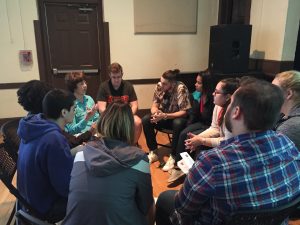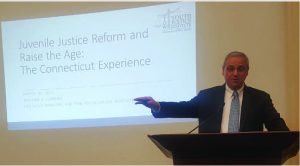
2017 Events
Restorative Justice Practitioner Convening
June 20, 2017
Restorative Justices Practices Project and CHDI (The Child Health and Development Institute) SBDI (School-Based Diversion Initiative) hosted a Restorative Justice Practitioner Convening with 43 stakeholders in attendance. Suffolk University Center for Restorative Justice staff collaborated with TYJI staff to develop and design the event as well as to co-facilitate the event at Community Solutions, Inc. Training & Resource Center in Bloomfield. The purpose of the event was to convene Restorative Justice Practices practitioners from across the state to connect and network on RJP efforts, projects and programs in CT in order to establish an RJP continuum, identify and share resources, and foster collaboration for an RJP framework.
Office of Juvenile Justice and Delinquency Prevention on “Lessons Learned From States That Have Raised the Age of Criminal Responsibility”
May 10, 2017
Tow Youth Justice Institute Executive Director William H. Carbone was a presenter at the above webinar, speaking about the Connecticut Experience. He began by putting Connecticut in Context, then discussed Connecticut Juvenile Justice System’s Outcomes “Before” Reform and Outcomes “After” Reform, how we got there, the strategic planning necessary, lessons learned and provided advice to NY as they move forward with the Raise the Age legislation.
Through a careful examination of results from the Justice Policy Institute’s recently released Raise the Age: Shifting to a Safer and More Effective Juvenile Justice System report, participants learned the process states took to raise the age of juvenile jurisdiction and how acts of legislation were part of larger reform efforts within these states to make the juvenile justice system more effective and fair.
The 13th
April 12, 2017
Nearly 85 students, faculty, staff and TYJI Leadership Alumni came together in small groups for a guided, facilitated discussion on the acclaimed documentary, 13th. Participants were asked to watch the documentary prior to attending the program in order to discuss how the language of the amendment created a loophole which resulted in the mass incarceration of African-Americans over the past 150 years. The documentary revealed staggering statistics contrasting the total population of the U.S. as 5% of the world’s population but having 25% of the world’s incar-cerated individuals. The documenta-ry explores the impact of legislative directives such as the declaration of the war on drugs and zero tolerance policies which contributed to the criminalization of African-Americans, as well as pervasive racial and ethnic disparity in the criminal justice system. Overwhelmingly, the student response to the program was positive and impactful and provided them with the opportunity to speak and share differing perspectives on the issue within the context of their academic and community experiences at the University. The Tow Youth Justice Institute was happy to support and co-sponsor with CJ Club, ACJA, Legal Society, Campus Climate Coalition, The Charger Bulletin, NAACP, BSU, and Kappa Kappa Psi.
Sharing Connecticut’s Experience with Raise the Age in New York State and Nationally
March 30, 2017
Given the Tow Youth Justice Institute’s (TYJI) role in supporting the JJPOC and the extensive expertise of its staff and faculty, the TYJI has become recognized as a leader in juvenile justice reform, and has been called upon to share the knowledge it has developed. When the State of New York’s Governor Mario Cuomo announced at the end of 2016, a new Youth Justice Institute to promote best practices to reduce recidivism, improve outcomes and enhance public safety, he cited the Tow Youth Justice Institute (TYJI) as the model to be replicated. To de-velop the strategies they would employ and begin a conversation about Raise the Age, the TYJI was called upon to present the successes in 4While every state has a different structure for the juvenile justice system and must create the path they will follow toward building a better system, many states that raised the age are exploring initiatives that are in alignment with the path to juvenile justice reform that Connecticut followed: • Expand the use of diversion.• Make probation and aftercare approaches more effective through the adoption of risk reduction frameworks, practices and programming.• Address young people’s mental health needs.• Reduce the use of pretrial detention.• Reduce reliance on facilities and focus resources on community-based approaches.Some of the major system reform efforts that have been implemented in addition to Raise the Age include:• Changing its community supervision approach to prohibit young people from being detained or re-committed to a facility based simply on a technical probation violation,• Relying more on home-based counseling and treatment thereby reducing out of home placements,• Using needs-based assessment instruments to assess what a young person needs and identify potential risks associated with his or her prior behavior, and• Using this information to align its practices through a cost-benefit lens.The Connecticut experience offers some advice for states now considering a raise in the age – take time to determine what needs to be measured and use a results-based accountability model; use a phased-in approach developed collaboratively with child welfare and public and private agencies; and determine how to create an infrastructure that includes staffing, training, programs, quality assurance, and performance outcomes.Connecticut in juvenile justice reform and how the Institute functions to support the work of juvenile justice reform.
By 2012, the State of Connecticut had raised the age of juvenile jurisdiction to 18. Prior to the passing of that legislation, Connecticut was one of only three states handling 16 and 17 year olds in the adult court system, even for minor offenses. Before the Raise the Age legislation, the juvenile justice system in Connecticut was experiencing some challenges. High court intake, high deten-tion admissions, poor conditions of confinement and lack of services.
Through the implementation of Raise the Age legislation and many other evidence-based practices and programs, Connecticut has become a bell-wether in system reform.
While every state has a different structure for the juvenile justice system and must create the path they will follow toward building a better system, many states that raised the age are exploring initiatives that are in alignment with the path to juvenile justice reform that Connecticut followed:
Expand the use of diversion.• Make probation and aftercare approaches more effective through the adoption of risk reduction frameworks, practices and programming.• Address young people’s mental health needs.• Reduce the use of pretrial detention.• Reduce reliance on facilities and focus resources on community-based approaches.
Some of the major system reform efforts that have been implemented in addition to Raise the Age include:
Changing its community supervision approach to prohibit young people from being detained or re-committed to a facility based simply on a technical probation violation,• Relying more on home-based counseling and treatment thereby reducing out of home placements,• Using needs-based assessment instruments to assess what a young person needs and identify potential risks associated with his or her prior behavior, and• Using this information to align its practices through a cost-benefit lens.
The Connecticut experience offers some advice for states now considering a raise in the age – take time to determine what needs to be measured and use a results-based accountability model; use a phased-in approach developed collaboratively with child welfare and public and private agencies; and determine how to create an infrastructure that includes staffing, training, programs, quality assurance, and performance outcomes.
Today, with reforms in place that began in 2007 with the first Raise the Age legislation, 16 and 17 year old’s are now in the Juvenile Justice System; the Connecticut Juvenile Training School (CJTS), the state’s only juvenile correctional facility, will be closing on July 1, 2018; status offenders are being removed from Juvenile Court entirely; there is reinvestment of savings in diversion; there are systems for accountability; and Raise the Age to 21 has been proposed by Governor Malloy.In addition to supporting the State of New York in their process of developing a reformed JJ system, the TYJI presented at national forums, and a webinar of the Office of Juvenile Justice and Delinquency Prevention in D.C. on May 10th. In addition to TYJI’s Bill Carbone, Marc Schindler, J.D., Executive Director of the Justice Policy Institute; Jason Ziedenberg, M.S., Director of Policy and Re-search at the Justice Policy Institute, and Marcy Mistrett, M.A., Chief Executive Officer at the Campaign for Youth Justice participated in the webinar
Capital Special Briefing – State Capitol
Moving from Institutions to Community-based Treatment in Juvenile Justice.
March 16, 2017
 The Tow Youth Justice Institute hosted a special briefing on building comprehensive community-based services and supports for children and families involved in the juvenile justice system. The panel discussion focused on:
The Tow Youth Justice Institute hosted a special briefing on building comprehensive community-based services and supports for children and families involved in the juvenile justice system. The panel discussion focused on:
- The impact of closing youth prisons on children, families and public safety.
- What a community-based continuum of care to address the needs of the children in the juvenile justice system must include to insure the best outcomes for the public and the children.
- The guiding principles and strategies from the recently released “Beyond Bars: Keeping Young People Safe at Home and Out of Youth Prisons”; a report from the National Collaboration for Youth that many states are considering as they seek new ways to reduce recidivism and keep communities safer.
Guest Speakers were:
- Marc Schindler, Executive Director, Juvenile Policy Institute
Marc is a dedicated justice system reformer serving in a variety of leadership roles at DC’s juvenile justice agency, Department of Youth Rehabilitation Services (DYRS) including Chief of Staff and Interim Director. Schindler also served as Staff Attorney with the Youth Law Center, advocating for the rights of young people in the juvenile justice and child welfare systems. Schindler is a recognized expert in the field, providing commentary in the national media, including on CNN and NPR, and is also the author of numerous articles and book chapters. - Shaena Fazal, Esq., National Policy Director, Youth Advocate Programs, Inc.
Shaena has been an advocate for the most disadvantaged individuals and to changing public policy throughout her career. Youth Advocate Programs is an international, community-based non-profit committed to the deinstitutionalization of high-need youth in the juvenile justice, child welfare, and behavioral health systems. In 2014, she authored the report “Safely Home”, which focuses on defining and building community-based alternatives for youth in the juvenile justice system. Shaena was awarded a two-year Soros Justice Advocacy Fellowship to continue her prisoner rights’ work, advocating for humane conditions for long-term prisoners in Illinois. - John Dixon, Associate Commissioner Close to Home Initiative Division of Youth and Family Justice NYC Administration for Children’s Services
John is a social worker, having received his MSW from the University of Connecticut. He has 33 years of human services work experience primarily in mental health, correctional and juvenile justice settings. John has worked in a variety of capacities including mental health worker, residential counselor, social worker, social work supervisor, quality assurance director, health services administrator, and facility director. Notably prior to working at ACS, John served as Superintendent of the Ct Juvenile Training School for 4 years and Deputy Secretary of the Maryland Department of Juvenile Services. He has participated in juvenile justice reform efforts across 3 states and has partnered with a variety of stakeholders to implement strategies to improve conditions of care within facilities and enhance community resources to support keeping children in their homes.

